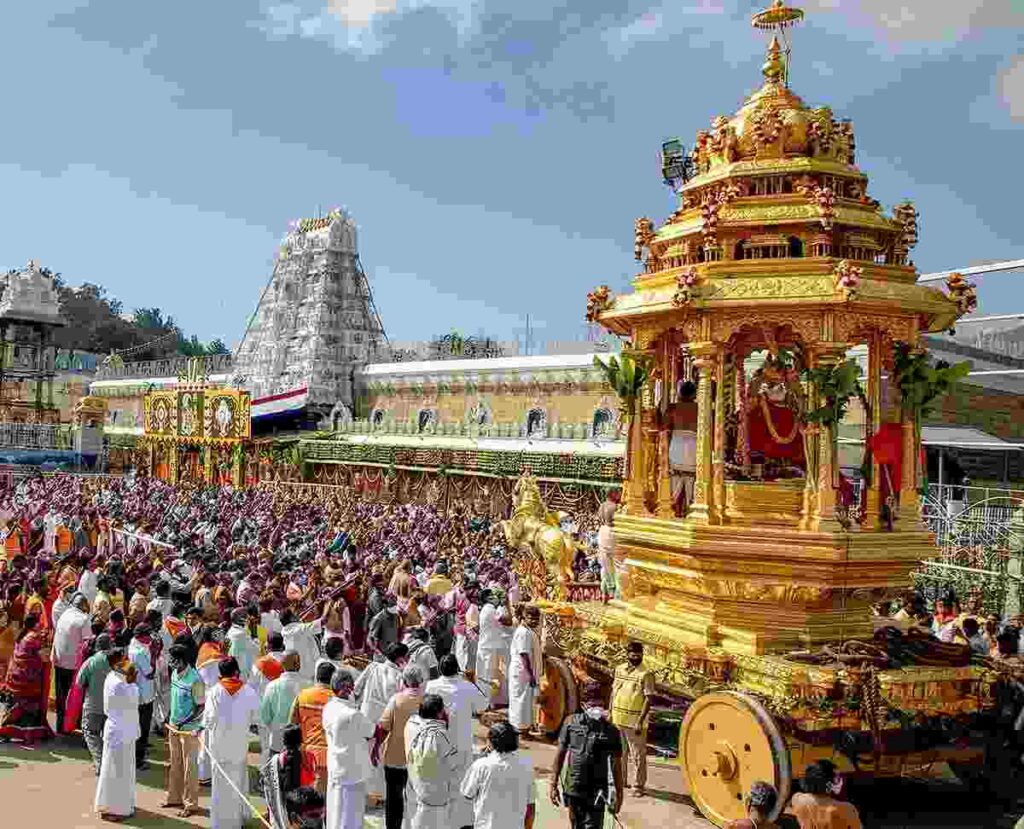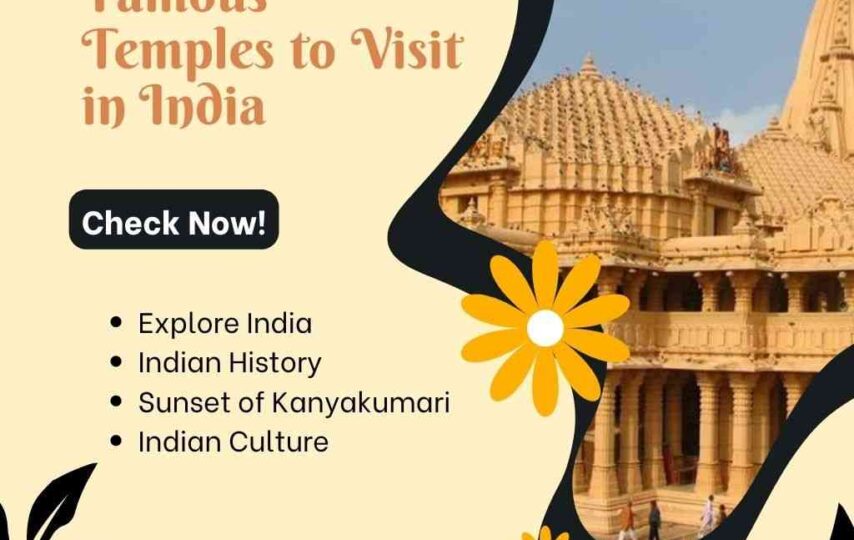Golden Temple, Amritsar

This stunning shrine, also known as Harmandir Sahib, is the most important temple in North India and the holiest location for Sikh devotion. The golden façade and religious importance of this temple, which was built in the middle of the 15th century on the banks of a man-made lake in Amritsar, are a tremendous draw, and both visitors and worshippers congregate at its doors in large numbers all year long.
Somnath Temple, Saurashta

Somnath is a historic site of worship and another temple that can be located in Gujarat. So much so that researchers have been unable to determine when the first temple was built here. The most recent reconstruction of the temple, which was completed in 1951, followed a few previous instances when it was damaged and rebuilt. Since then, it has grown to be one of India’s most well-known Hindu temples.
Tirupati Balaji, Tirumala

This hilltop temple, which is officially known as the Venkateshwara Temple, is devoted to Lord Venkateshwara, who is a manifestation of Lord Vishnu. Along with its stunning architecture, this temple has the title of being the wealthiest Hindu temple in the entire globe.
Padmanabhaswamy Temple, Thiruvananthapuram
The famed Padmanabhaswamy Temple is located in Kerala’s state capital. This temple honouring Lord Anantha is truly the name Thiruvananthapuram from. Another intriguing aspect of the temple is that it has always been in the care of the Royal Family of Travancore.
Maa Vaishno Devi Temple, Katra
One of the most significant temples in India is Vaishno Devi, which is situated in the Jammu and Kashmir region in the foothills of the powerful Himalayas. Every year, thousands of devotees travel to this temple to pay their respects to Goddess Vaishnavi, the patron deity of this shrine. A 12-kilometre journey is needed to get to the temple. To reach the summit, devotees have a variety of alternatives, including walking, riding a horse, or even using a helicopter.
Brihadeshwara Temple, Thanjavur
Brihadeeshvara, another temple in the Tamil Nadu region of southern India, is a representation of the Chola Dynasty. This temple was constructed in the years 1003–1010 AD, hence it is also quite old. Additionally, this temple contains one of India’s biggest Shiva lingas.
Jagannath Temple, Puri
Jagannath Puri, one of the oldest temples on our list, was built in the 12th century and is a Lord Vishnu shrine. In addition to being a magnificent architectural structure and one of the holiest sites for Hindus, it is well-known for the elaborate rath yatra it organises each year.
Konark sun Temple, Konark
Every year in February, this fabled temple, which favours Surya, the solar deity, conducts the celebrated Chandrabhaga festival. This 100-foot-tall temple was constructed in the year 1250 to resemble a chariot. Despite significant degradation and damage, it is still a lovely edifice to see.
Badrinath Temple, Uttarakhand
The Badrinath Temple is located in Badrinath, which is bordered by the Garhwal Hills. Badrinath Temple, the third char dham on our list, is devoted to Lord Vishnu. It is one of India’s most recognisable temples thanks to its stone fascia and glistening golden dome. This temple also participates in the historic Mata Murti Ka Mela.
Virupaksha Temple, Hampi
The UNESCO World Heritage temple town of Hampi in Karnataka is home to this well-known temple. The temple, which dates to the seventh century, is devoted to Lord Virupaksha, an incarnation of Lord Shiva. One of its most notable features is its nine-story, almost 165-foot-tall gopuram. This temple is the gem in one of India’s most important historical crowns because it is surrounded by ancient artefacts and steeped in a history of tradition.
Dwarkadheesh temple, Dwarka
This temple, another one of the char dham, is more than 2000 years old. Here, Lord Krishna is the most worshipped god, and the main temple is a five-story structure supported by 72 pillars. According to legend, this temple was erected exactly where Lord Krishna’s legendary castle once stood.
Lingaraja Temple, Bhubaneshwar
One of the largest and oldest temples in Bhubaneswar, Lingaraja Temple is also one of the oldest. The 700th century is when this historic Indian temple’s main tower, which is 180 feet tall, was first built.
Kashi Vishwanath Temple, Varanasi
One of the most beautiful sites of worship in Varanasi is this well-known temple. Kashi Vishwanath, a shrine to Lord Shiva, is located along the Ganges River. The Dashashwamedh Ghat, one of the most important ghats in the region, is situated very near to the temple. Every evening, the legendary Ganga Aarti is performed here
Ramanathaswamy Temple, Rameshwaram
This temple, which is a part of the holy char dham, is situated on the Pamban Island, which is located off the coast of India. In its present shape, the temple dates back to the 12th century. One of the most well-known temples in South India is devoted to Lord Shiva.
Meenakshi Temple, Madurai
Although it has been a centre of worship for much earlier than that, the Meenakshi Temple only took on its current, opulent shape in the 12th or 13th century. This enormous temple is devoted to the goddess Meenakshi and is situated in the centre of Madurai (an incarnation of Parvati). Its spacious halls are always crowded with worshippers, and the three-story gopuram or entry tower that stands over its gate is particularly distinctive.
Shri Padmanabha Temple, Kerala
A majestic statue of Lord Vishnu resting on Anantha, the five-hooded snake, is housed at the Shri Padmanabha Swamy temple in Thiruvananthapuram, the state’s capital city (formerly known as Trivandrum). Additionally, as Lord Vishnu is the third god, the idol depicts the three trinities of Lord Brahma, Lord Shiva, and Lord Vishnu. A lotus may be seen emerging from the idol’s navel, where Lord Brahma is sitting. The lord is known as Padmanabha as a result (padma means lotus and nabha means navel). The Shiva Lingam emerges from the idol’s right palm. One of the most significant Vishnu temples in the nation is this one.
Dwarkadhish temple, Gujrat
The Dwarkadhish temple, one of the Char Dham temples, is a famous site for Hindu pilgrimage. It is estimated that the temple is older than 2500 years. The temple, which is devoted to Lord Krishna, has five levels and is supported by 72 pillars, which is an astounding feature of the building. Swarg Dwar, which means “the door to heaven,” is the entrance, while Moksha Dwar, which means “the door to liberty,” is the exit. This temple is open during the morning and evening time but closed in the afternoon time.
Amarnath Cave Temple, Jammu, and Kashmir
Amarnath cave shrine, one of the most famous Hindu pilgrimage destinations in the world, is magnificent and enchanting. The Shivalinga is naturally constructed here from ice. It is around 141 miles from Srinagar, the state capital, and is located in a small ravine in the Lidder valley. Only June through August are the only months the temple is open. Reaching the cave is a difficult journey that involves enduring a hostile environment and a long hike.
Gangotri Temple, Uttrakhand
It is said that Lord Shiva received Ganga in his hair at the Gangotri temple, which is situated in the Uttarkashi area. One of India’s holiest pilgrimage sites, the temple is made of white granite. The idol is transferred to the Gangotri temple from the Mukkyamath temple, where it is stored for the remainder of the time, during the month of April or May, when the temple is only open once a year.
Sabarimala temple, Kerala
The Sabarimala temple in Kerala, which is situated on the Western Ghat, is perched on a peak and encircled by 18 hills and thick woods. It is also one of the busiest locations for yearly pilgrimages in India, drawing an estimated 50 million or more visitors each year from all walks of life, faiths, castes, and creeds. Lord Ayyappa, the son of Lord Shiva and Mohini, the feminine embodiment of Lord Vishnu, is the subject of the Sabarimala shrine.
Shri Jagannath Temple, Odisha
Another well-known temple, not just in Odisha but throughout the nation and the globe, is the Shri Jagannath Temple. It is located in Odisha’s Puri district. Given that it is one of the four temples that make up the Char Dham or sacred pilgrimage, it is one of the most respected Hindu religious sites. Lord Balabhadra and Subhadra are also housed at the temple, which is devoted to Lord Jagannath or Lord Krishna.
Shirdi Sai Baba Temple, Maharashtra
The Shirdi Sai Baba temple, which was built in the saint’s honour, has his Samadhi as well. It is one of the few temples in India that allows visitors of all religions, and it is situated in the little Maharashtrian town of Shirdi. Sai Baba advocated harmony and peace, and followers continue to study and listen to his teachings. One of Sai Baba’s most well-known sayings is “Shraddha-saburi,” which translates to “faith and compassion.”
Yamunotri Temple, Uttarakhand
The temple contains a black marble idol of the goddess Yamuna and is situated at a height of 3291 meters. The numerous hot springs beside the shrine are another draw. Devotees must also make a long trip to the temple because there is no other way to get there.
Khajuraho Temple, Madhya Pradesh
One of its other distinctive qualities is its magnificent architecture, which includes tasteful carvings and sculptures. Built of sandstone, it is constructed in such a way that the temple is supported by gravity, a wonderful feature that demonstrates how advanced ancient construction was. It is also a centre for pilgrimage and one of the most visited tourist destinations in the nation. The many engravings of sexual sculptures are another noteworthy feature.
Siddhivinayak Temple, Maharashtra
One of the most well-known and beloved temples in India is the Siddhivinayak Temple, which is devoted to Lord Ganesha. Devotees from all over the nation travel to its location in Mumbai, the state’s capital, in the Prabhadevi neighborhood. The temple is conveniently located on a prominent thoroughfare.
Conclusion
Given that there is a temple every three kilometers or more in every part of a city or village, India is sometimes referred to as a land of temples or religious buildings. A daily practice for the majority of Indians is visiting a temple to offer worship to the lord. These temples are also a significant component of India’s cultural history because many of them have remarkable architecture and date back many centuries. These temples’ significance is increased by the numerous tales connected to them. In India, there are several temples that you absolutely must visit because of their significance in mythology and history, as well as because they are architectural wonders and reminders of India’s illustrious past. Above are listed the top famous temples one should visit across India.
People Also Search About Famous India Temple
- Top 10 richest temples in India
- Most beautiful temples in India
- Temples in India
- Hindu temples in India
- Biggest temple in India
- Richest temple in India
To check More Blogs- Places to visit in Barsana, Shri Ji Temple Barsana, Kirti Mandir Barsana , Prem Temple Vrindavan, Places to visit in Vrindavan, Radha Raman Temple Vrindavan, Shri Krishan Janambhumi Mathura, Goverdhan Hill Mathura, Shani Dev Temple Mathura, Places to Visit Nandgaon, Maan Mandir Barsana, Shri Radha Kushal Bihari Temple, Dan Bihari Temple Barsana, What is Nandgaon Famous for, Best Food in Vrindavan

